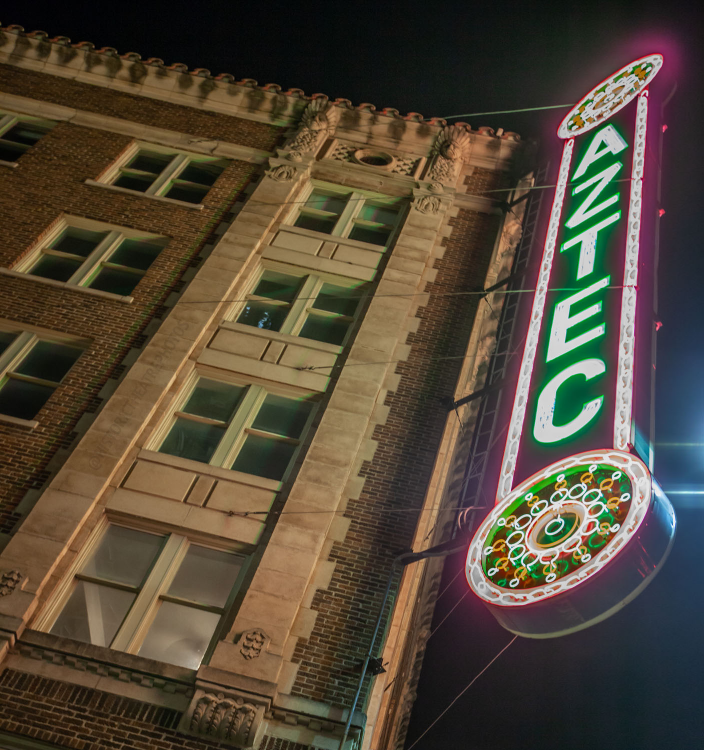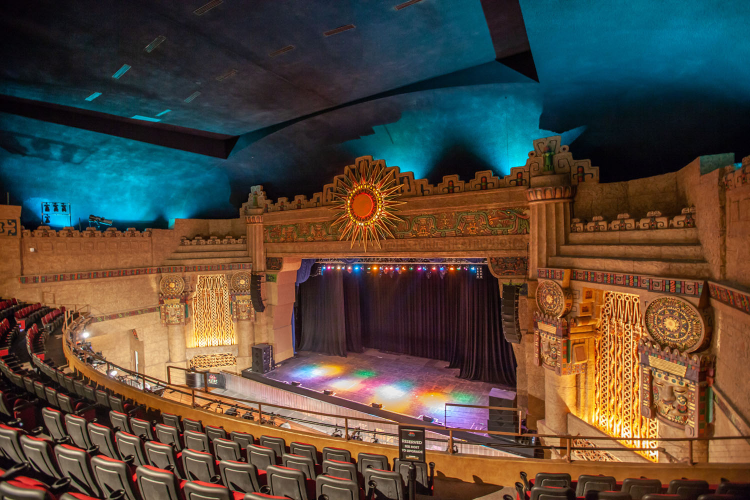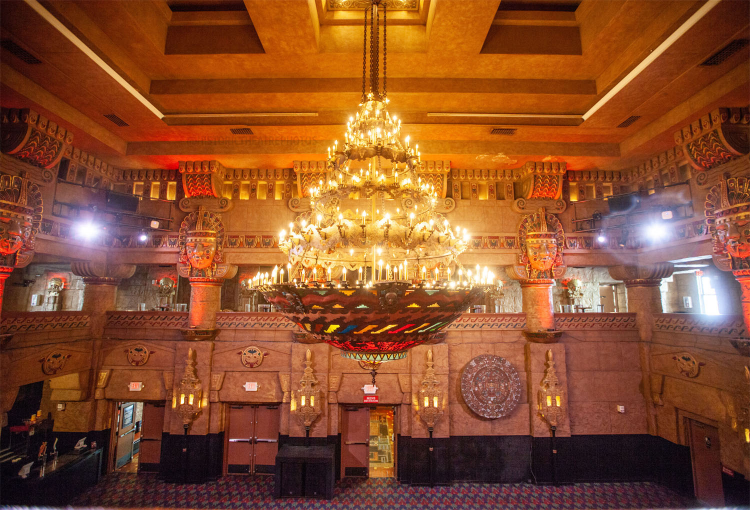The Haunted Aztec Theatre

The Haunted Aztec Theatre stood tall, its grandeur unmatched even today except for a select few brave souls who dared to enter its halls. However, with the fall of the darkness, something came alive in the theatre: ghosts, or someone, which the world had long forgotten.
Those who had ventured inside had reported strange occurrences, voices echoing through the theatre when no one was there, and the feeling of being watched. The ghostly sightings had become so common that the once proud theatre had become a haunt, a place avoided by many.
One ghost that had made its presence known was in the projector room. The story goes that anyone new to the projector room must undergo a test to prove the newbie’s worth. The ghostly figure would prank the hapless operator to test their nerves.
As the years rolled on, the story of the Aztec Theatre spread far and wide. Scary stories told around a campfire, the mysterious theatre had become a legend in its own right. One day, a group of adventurous teenagers decided to take a chance and explore the haunted theatre.
As they made their way through the dark hallways, the feeling of unease grew with every passing step. The theatre had an eerie quietness to it. However, as they turned a corner, they saw something that would haunt them for the rest of their lives.
In the distance, they saw a light flicker from the projector room. Not believing their luck, they hurried towards it, eager to see if the stories were true. As they entered the room, they saw the figure of a man working on the projector, oblivious to their presence.
As they got closer, they suddenly realized that the man wasn’t alive but a ghostly figure dressed in old-fashioned clothing. Fear gripped them as they tried to back away, but it was too late. The ghostly figure turned and looked straight at them, a chilling smile on its face. And then, in an instant, it vanished, leaving the teenagers in stunned silence.
What The Aztec Theatre is Haunted
The Aztec Theatre is one of three existing theatres designed in the Mayan style, the others being the Mayan Theatre in Los Angeles, California, and the Mayan Theatre in Denver, Colorado. The Fisher Theater in Detroit, which opened with 3,500 seats in 1928, was once a great example of the style but was renovated in the early 1960s to a smaller 2,100-seat playhouse furnished with modern decor.
In the mid-1920s, a coalition of influential San Antonio business people created the Commerce Realty Company to build a movie theatre for the city. The Kelwood Company appointed its principal architect, Robert B. Kelly, to undertake the project with help from interior designer Robert O. Koenig, and the total cost was $1.75 million.
The six-story office building was to be transformed into a theatre with a Mesoamerican theme, drawing inspiration from the Aztec, Mayan, Mixtec, Toltec, and Zapotec cultures. To achieve this, Kelly and Koenig took several months to study and research Mexican archaeological sites and museums, specifically in Mexico City. They used their findings to construct models and sketches.
The Old South Cafe, which was situated in the basement of the theatre building, quickly became a hit when it opened in the mid-1920s. It served classic Southern-style comfort food for two decades until it was converted into a Mexican restaurant. Patrons could only access the cafe by a single stairway connected to the main entrance, and often a queue could be seen forming on the steps.
The architecture of the Aztec Theatre’s auditorium was crafted in an “atmospheric” style. John Eberson is the leading designer associated with this style, where the chamber’s atmosphere is crafted to suggest a particular time and place, usually outdoors with a high, blue sky and twinkling stars and moving clouds. The Majestic Theatre in San Antonio is an excellent example of an Eberson atmospheric auditorium.
When the Aztec Theatre was first established, its auditorium was referred to as “atmospheric” due to its starlight and cloud-like effects that were created through the lighting.
Haunted Theatres Can Be Beautiful

The Aztec ceiling has undergone some changes over time (e.g., being raised and flattened in the center to fit a now-absent IMAX-like movie screen); however, its original form was curved and featured no visible lines or joins. It was painted to appear like the sky, with around 100 twinkling stars and four projectors behind the sidewalls would project moving cloud lighting effects onto it. The hidden cove lighting would also adjust its hue to the season, such as a cool blue for the summer months and a warmer red for the winter.
The auditorium of the Aztecs is distinguished from other atmospheric theatres by its symmetrical architectural elements. Beneath the proscenium is a series of Doric columns. These are accompanied on their inner edges by plasterwork that ascends from the stage floor to the proscenium and appears carved from stone. Flanking the proscenium are two columns which also give off the impression of having been carved from stone. Adorning these columns are organ grilles comprising writhing golden serpents (representing the sacred Quetzalcoatl) and various wave and circle patterns – symbols of water and sand in Mesoamerican culture. On top of the columns are sculptures of Coyolxauhqui, the Aztec Moon goddess, with glowing red eyes and Aztec sunstones sitting atop their heads. The stepped-back “roofs” above the organ grilles are modeled after Mayan or Aztec stepped pyramids.
The top of the proscenium is decorated with a large and low-relief horizontal carving, resembling those seen in the Temple of the Plumed Serpent in Xochicalco. It depicts the holy serpent Quetzalcoatl. Above the proscenium panel are 20 colossal stepped blocks, each with a different illustration symbolizing the 20 Day Signs of the Aztec and Mixtec calendars.
A detailed monumental sun symbol was situated at the center of the proscenium. It could be illuminated with a blend of shades (initially documented as 20 distinct colors, potentially linked to the Aztec/Mixtec Day Signs or their base-20 numerical system). The custom was to have the sun device always lit in gold after a performance.
A grand four-story lobby With a colossal one-and-a-half-ton chandelier

The lobby of this four-story building is impressive, featuring a massive chandelier weighing one-and-a-half tons and two stories tall and 12ft wide. When added to the theatre in 1929, it was declared the most enormous chandelier in Texas. In light of the Majestic Theatre opening only a couple of blocks away, management decided they needed to raise the level of grandeur at their theatre and commissioned the chandelier, which was made of steel and glass, in only 35 days. Beneath the chandelier sat a circular sacrificial altar stone with intricate carvings, but it was sold in the 1960s and taken out of the theatre.
The lobby at orchestra level is illuminated with 16 wall lamps placed on top of slender columns, designed with a ceremonial staff motif and incorporating Mayan detailing. These lamps have heraldic emblems, providing a warm, golden light radiating throughout the lobby.
Detailed murals are in the lobby, modeled after the Lintel 39 from Yaxchilan and the Mayan Temple of the Sun at Palenque. Furthermore, the upper corners of the stairway portals have serpent head brackets placed in homage to the Aztec practice of having such figures at the bottom of ceremonial stairways. An example is Kukulk an, the feathered Mayan snake god, at the base of the steps of the Pyramid of Kukulk an at Chichen Itza.
A sculpture in a theatre lobby modeled after Zapotec funerary urns is featured in the image above.
On the mezzanine level, sixteen large curved columns outline open-view galleries, visible from the lower orchestra-level lobby. The columns have an apparent cut-stone look and have been said to be motivated by the Hall of Columns from the historic site of Mitla in the south of Oaxaca. On top of the columns are the brightly colored heads of Coyolxauhqui, the Aztec moon deity with glowing red eyes. The three coffers in the lobby ceiling were once decorated with blue sky and white clouds to give the feeling of being in a temple.
The theater’s main entrance was once accessible from the street, but now it is completely blocked off with glass panels. Inside the vestibule, the floor has been decorated with brightly-hued tiles, and the ticket booth stands out, resembling a stepped Mesoamerican pyramid. Initially, the ticket booth was secured by black iron bars that were molded into the shape of arrows and painted accordingly.
On the evening of June 4th, 1926, the Aztec Theatre opened its doors to a crowd of excited patrons. An orchestra of 26 members, accompanied by chorus girls, played to a group of 6,000, of which 3,000 could be seated in the theatre’s 2,500 capacity.
The Wurlitzer organ console of the theatre can be seen in the VIP Warrior Room Lounge.
The theatre was initially outfitted with a 3-manual, 11-rank Robert Morton theatre organ (opus 18586) brought back to life by Ed Gaida in 1958. As of 2019, the organ pipes remain in the original chambers, while a Wurlitzer console (installed onto the balcony in 2006) is on display in the VIP Warrior Room Lounge on the House’s Right side of the auditorium.
Bombing At The Haunted Aztec Theatre
In 1932, a stench bomb exploded in the theatre, injuring six people – two of them gravely. The bombing was the fourth incident in San Antonio since 1930, part of a more significant trend throughout the nation as theatre workers affected by the Great Depression pushed for better wages and staffing.
Paramount Pictures, through their subsidiary Hoblitzelle & O’Donnell, managed a theatre with a seating capacity of 2,451, according to the Film Daily Yearbook of 1943.
The Aztec had a lengthy period of popularity, but, like many other single-screen cinemas in the same era, it was converted into a triplex in the 1970s in response to the rise of television. The theatre’s sign was updated with the addition of “3” beneath the word AZTEC, and it was publicized as the Aztec Triplex.
Two heraldic lamp standards frame the Sun Stone in the lobby.
In 1988, the San Antonio Conservation Society took action to protect the theatre from the possibility of destruction to make way for parking or a hotel by buying it. Despite this, films were only screened for one more year before it ceased operations in 1989.
In 1992, the theatre was given a National Register of Historic Places listing as the only remaining Mayan Revival style theatre in Texas and one of the very few and finest examples of this style in the country. In August of 1993, the San Antonio Conservation Society attempted to sell the Aztec Building, insisting that the purchaser would restore the theatre to its original 1920s condition. Suggestions for potential uses were suggested, like becoming the new home for the San Antonio Symphony, a dinner theatre, or a Spanish-language TV studio—still, the plans needed to be carried out.
In 1998, Baron Theodore Bracht from Belgium obtained the building to convert it into a family restaurant and entertainment facility. In Spring 2000, a $20 million effort to renovate the building commenced, including expanding its structure underneath Crockett Street between the theatre and the San Antonio River Walk, allowing for a direct path to the theatre from the renowned River Walk. Initially, the underground area featured “a museum-like exhibit” with the 1920s-era machinery used to operate the theatre; however, as of 2019, the space is now occupied by retail, and there is no longer public access to the theatre.
2006 the renovation was complete, and Aztec on the River made its grand opening on April 1st. There were several features included in the theatre’s reopening.
In 2006, a theatre was built with an iWERKS “Extreme” screen, measuring 60ft by 45ft (18.3m by 13.7m) and capable of retracting into the auditorium ceiling. It was used to show large-format edutainment films such as “Journey Into Amazing Caves” (2001) and “Mystery of the Maya” (1995).
The theatre had an audience capacity of 483, utilizing large-style movie seats on the balcony level only.
Also installed at the House’s Left side of the balcony was a 1931 Mighty Wurlitzer theatre organ console (opus 2173). This console was originally installed in the Paramount Theatre in Boston, Massachusetts, and has been in storage since December 1997. The 1,700-piece organ pipe and percussion system was purchased from Oral Roberts University and was given reconditioning, including computer playback controls
The grand lobby’s imposing chandelier was refurbished by Ted Voss, the grandson of Theo Voss, who had originally designed it in 1929. The chandelier was cut into two pieces to be transported to Mr. Voss’s shop for rehabilitation.
As part of a free show to attend, the lobby featured eight-minute special effects showed using light, animatronics, smoke, and fire to depict an ancient Aztec legend and ran every 90 minutes. This display included a giant snake magically rising out of an urn, though the animatronic snake does not appear to have survived. However, as of 2019, the urns, which had been matched to the 1926 decor, were still in storage.
The large friezes surrounding the Balcony cross-aisle exits had been destroyed, which prompted Rick Armendariz, a UTSA art professor, to recreate them based on black-and-white photographs and slivers of the remaining painted plasterwork.
The fire curtain that was painted originally illustrates the encounter between Hernando Cortez, a conquistador, and Montezuma, the Aztec ruler, in 1519.
At the end of 2007, the movie theatre Aztec on the River sadly shut its doors, unable to gain a foothold in the area and attract moviegoers. A big part of this was caused by its selection of films, which seemed outdated compared to the modern movies and 3D features at the nearby IMAX theatre in Rivercenter, just a short distance away.
In 2008, Drury Hotels closed a deal to lease the theatre and revive it as a music venue, titled San Antonio Rose Live. It presented a two-hour show inspired by Branson, Missouri style, with Country, Western swing, and Gospel music as its main attractions and performed by Darrell McCall. A 4 million dollar investment was made, and the show was launched on September 21st, 2009. Nonetheless, after two-and-a-half years of performance, the production was discontinued in February 2012 due to “current and future economic circumstances.”
The theatre’s organ grilles are decorated with representations of Quetzalcoatl, the sacred serpent.
In 2013, Samuel Panchevre’s PHH Ventures LLC inked a multi-year lease to run the Aztec Theatre. A $2 million renovation was completed to transform the theatre into a live entertainment venue, boosting its capacity from 1,700 to 2,000. The original orchestra seats were removed and replaced with terraced flooring equipped with chairs, cocktail tables, or standing space – with a bar in the center to serve the area and a “mosh pit” dancefloor close to the stage. The theatre opened again in February 2014, with a soft opening on Valentine’s Day.
At the beginning of 2015, Samuel Panchevre acquired the building, and prior to the close of that same year, Live Nation purchased a 51% stake.
House of Blues Entertainment, a part of Live Nation, is the current programmer and manager of the Aztec. Its portfolio contains sites such as The Wiltern in Los Angeles and The Tabernacle in Atlanta, as well as several other concert halls in the U.S. that are flying the House of Blues flag.
